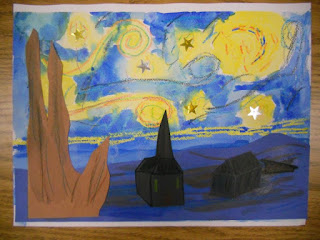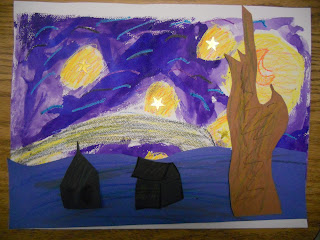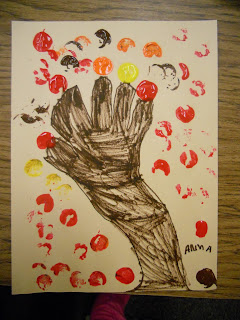 |
| Look at those muscles! |
I saw that another blogger, mccann at Doodles & Noodles, added another dimension to this project by having the children include the shadows of their figures. I thought that was an interesting idea. Not only does it look great visually, but it is interesting to compare the original gesture drawing of the figure to the 3D sculpture and the contour of the shadow.
Giacometti Figure Study
Supplies Needed:
- A few sheets of 8 1/2" x 11" copy paper
- Pencil
- A manikin, if possible (I bought mine at IKEA for $5) and a friend to draw
- 3-4' section of aluminum foil (I buy mine at the Dollar Store)
- Hot glue gun and glue sticks
- Matte board or thick cardboard
- One 9" x 12" piece of black construction paper
- Stapler
- Scissors
- Glue stick
- Lamp (we used a flashlight but that moved too much)
Directions:
1. Warm up by drawing a few gesture drawings of the figure in different poses. I talked briefly about the shapes that make up the human figure and how to draw the figure step-by-step. As the students posed, I posed Manny, the manikin, into the same pose so we could talk about the parts of the body and how they were arranged in each pose. I pointed out how the parts of the body joined and how they bent. Many times, young students will add too many joints or make knees bend the wrong way (OUCH!). One of my students asked, "When did this become a science lesson?" And it's true, learning to draw from life forces us to study and learn the structure of objects and beings.
2. Choose a pose to use as inspiration for your sculpture. I gave each student a 3'-4' piece of foil. I demonstrated how to shape a figure from the foil. I suggest scrunching the foil lightly at first to get the overall shape of your figure down and then squishing the foil to be more compact once you have all of the parts figured out. I really encouraged the students to create the figure from the one piece of foil and not pull off bits of foil, make parts, and then try to join them into a figure. Once you have your figure, pose it in the way it should be, using your drawing as a guide.
3. Use the hot glue to tack the figure's feet to the matte board.
4. Slip a piece of white copy paper under the foil figure's feet in the direction you want your shadow to fall. Place the entire sculpture in front of a lamp or bright light source so that a shadow comes from the foil figure and goes across the white copy paper. Trace the shadow onto the copy paper using pencil.
5. Compare the contour of the shadow to the gesture drawing you originally made--how are they different? How are they the same?
 |
| The elements of the Giacometti Figure Study (clockwise from top): Manny the manikin, the gesture sketch, the shadow tracing, and the completed foil figure. |
6. Staple the white copy paper with the shadow on it to a piece of black construction paper. Using your pencil line as a guide, cut through both layers to create a shadow from the black paper. Remove the staples and glue the shadow to the matte board using a glue stick. Note: Make sure you glue your shadow down facing the proper way--some kids tried to glue their shadows on upside down! Also, make sure that you slip a bit of your shadow under the foil figure's feet--shadows start UNDER our feet.
And Yet ANOTHER Science Link: If you had the luxury of time and patience, you could trace your foil figure's shadow throughout the day (say three times?) and cut each shadow from a different color of construction paper and then layer them on the matte board to show the passage of time or how our shadows change as the sun's position changes...just sayin'. That would be pretty awesome! ENJOY!
 |
| "Running To A Friend By The Sea" |






























